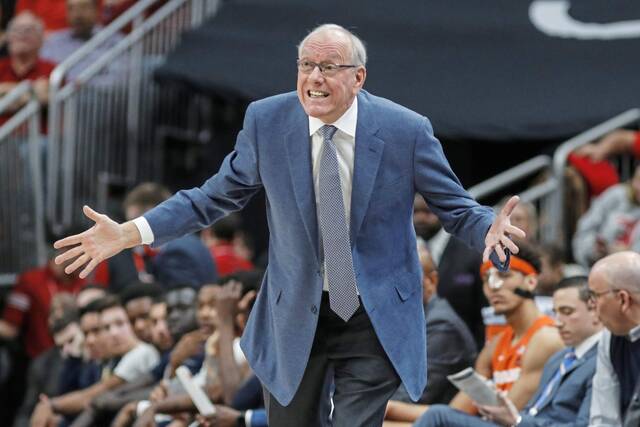https://triblive.com/sports/pitt-looks-for-cracks-in-syracuse-coach-jim-boeheims-zone-defense/
Pitt looks for cracks in Syracuse coach Jim Boeheim's zone defense

Two weeks ago, Pitt’s John Hugley received his first taste of Syracuse’s distasteful (to opponents, at least) 2-3 zone defense.
In a 77-61 loss inside Syracuse’s Carrier Dome on Jan. 11, Hugley scored eight points, more than seven off his team-leading average of 15.8 per game. It was one of the few times this season the Panthers weren’t competitive in the second half.
Bad news for Pitt: The zone is back.
Syracuse (9-10, 3-5 ACC) brings its infamous and iconic zone to Petersen Events Center on Tuesday for an 8 p.m. tipoff against Pitt (7-12, 2-6) on the ACC Network. Pitt has lost five of its past seven games, all in the conference, and is only ½ game ahead of last-place Georgia Tech (8-10, 1-6).
Playing the zone without reliable perimeter shooting isn’t ideal, but that’s the situation where Pitt finds itself. Pitt is last in the ACC with a 30.1% percentage beyond the 3-point arc.
The good news is Jeff Capel knows Syracuse coach Jim Boeheim and what makes the zone so formidable — in its best days, anyway. Syracuse has troubles of its own, most recently a 79-59 loss at Duke on Saturday that gave the Orange a 2-5 record in its past seven games.
Capel and Boeheim were together on Mike Krzyzewski’s USA Basketball coaching staff, winning the gold medal at the 2016 Rio de Janeira Olympics. They have matched strategies in the ACC for years, either as coach vs. coach or coach vs. player when Capel played at Duke.
The zone has helped Boeheim craft a 46-year career with 991 victories, including a national championship and five Final Fours.
“Coach Boeheim recruits to it. They believe in it. It’s different from a traditional 2-3 zone,” Capel said. “The zone can morph throughout the season.”
In a few games this season, the zone swung from a conventional 2-3 look to a 1-1-3 that Boeheim tinkered with to take away the high post, a popular attacking point for opponents. The results included Indiana committing 26 turnovers in Syracuse’s 112-110 double-overtime victory and Florida State missing 26 of 30 3-pointers in the Seminoles’ 63-60 defeat.
But when the zone isn’t working, it could be disastrous for Syracuse. Colgate beat the Orange 100-85 by hitting 18 3-pointers.
Pitt had no such luck at the Carrier Dome, suffering through a 12-minute stretch spanning both halves when Syracuse outscored the Panthers, 31-9. Pitt didn’t score its first basket of the second half for 9 minutes, 16 seconds.
Capel hopes video review of that game and practice over the past two days will help.
“We hope (Hugley) is more comfortable,” Capel said. “That was his first time ever playing against Syracuse. For most people, the first time you play against them it’s different because it’s not a traditional zone. It’s different. It’s very, very different.
“Most of the teams play man-to-man or a variety of man-to-man. So, it’s something that’s pretty unique and they do a heckuva job teaching it, recruiting to it and executing it in games.”
The zone works best with long guards on the perimeter and Boeheim has one of the best. His son, Buddy Boeheim, a 6-foot-6 senior, is a formidable defensive presence while standing fourth in the ACC in scoring (18.6 points per game). Junior guard Joseph Girard III is third in the conference with 35 steals.
“Long athletes everywhere. Bigger guards, usually,” Capel said. “Big wings, athletic wings, shot blockers in the middle.”
Boeheim, 77, said he was first exposed to the 2-3 zone in high school – he’s a native of the small, upstate New York town of Lyons where his family owned the local funeral home – and later at Syracuse where he played guard, starting out as a walk-on.
“Played it in high school, played it in college,” he said Monday on the ACC coaches conference call. “Not all of the time, some of the time. Then, when I started coaching, we used it 20-25% of the time and then it grew a little bit to 50-50. It fluctuated over the years.
“A number of years ago, I decided to switch to the 2-3 zone permanently and that’s what we’ve been playing since then. It’s changed a lot, but it’s still basically a 2-3 zone.”
The trigger might have been an exhibition loss to Division II Le Moyne (N.Y.) College in 2009 while Boeheim was experimenting with a man-to-man defense.
Boeheim told The Athletic the loss “might have been the best thing that ever happened to me, because I stopped fooling around and we got more into practicing the zone.”
That season, Syracuse won 30 games and advanced to the Sweet 16.
Why has it been so durable?
“We’ve been able to win with it, I guess,” he said. “That’s how these things last.”
Copyright ©2025— Trib Total Media, LLC (TribLIVE.com)
